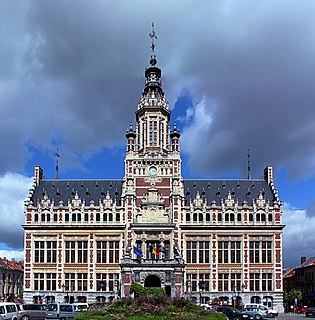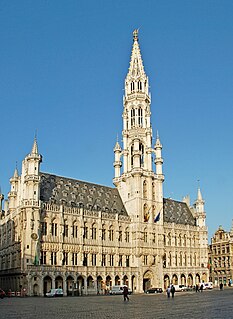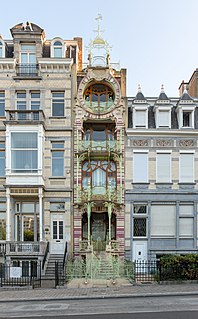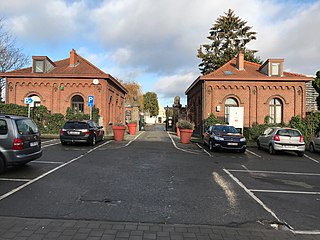
Saint-Josse-ten-Noode or Sint-Joost-ten-Node, often simply called Saint-Josse or Sint-Joost, is one of the nineteen municipalities in the Brussels-Capital Region of Belgium. It is bordered by the City of Brussels and Schaerbeek.

Schaerbeek or Schaarbeek is one of the 19 municipalities of the Brussels-Capital Region, Belgium. Located in the north-eastern part of the region, it is bordered by the City of Brussels, Etterbeek, Evere and Saint-Josse-ten-Noode. In common with all of Brussels' municipalities, it is legally bilingual (French–Dutch).

The Town Hall of the City of Brussels is a landmark building in Brussels, Belgium. It is located on the famous Grand Place, opposite the King's House or Bread House building housing the Brussels City Museum.

The Palace of Coudenberg was a residence situated on the Coudenberg or Koudenberg, a small hill in Brussels in modern-day Belgium. For nearly 700 years, the Castle and then Palace of Coudenberg was the seat of government of the counts, dukes, archdukes, kings, emperors and governors, who from the 11th century until its destruction by fire in 1731, exerted their sovereignty over the area of the Duchy of Brabant, now in the southern Netherlands and northern Belgium. After several years of recent excavations, the archaeological vestiges of the palace and its foundations are open to the public.

Gustave Strauven was a Belgian architect. His father was a gardener from Limbourg and he died in World War I. He was an art nouveau architect and he liked to use new technologies. He created more than 30 buildings, incorporating wrought iron floral motifs.

La Cambre Abbey or Ter Kameren Abbey is a former Cistercian abbey in the City of Brussels (Belgium). It is located in the Maelbeek valley between the Bois de la Cambre/Ter Kamerenbos and the Ixelles Ponds. The abbey church is a Catholic parish of the Archdiocese of Mechelen-Brussels and home to a community of Norbertine canons, while other parts of the monastery house the headquarters of the Belgian National Geographic Institute and La Cambre, a prestigious visual arts school.

The Place Royale or Koningsplein is a historic neoclassical square in the Royal Quarter of Brussels, Belgium. Modelled after the so-called French royal square and built between 1775 and 1782, according to a plan of the architects Jean-Benoît-Vincent Barré and Gilles-Barnabé Guimard, to replace the former Palace of Coudenberg, it was part of an urban project including Brussels Park.

Schaerbeek Cemetery, officially Schaerbeek New Cemetery, is a cemetery belonging to the municipality of Schaerbeek, Brussels (Belgium), where the inhabitants of Schaerbeek have the right to be buried. It is not located in Schaerbeek itself; rather it is partially in the neighbouring municipality of Evere, and partially in the village of Sint-Stevens-Woluwe in the municipality of Zaventem in Flemish Brabant. The cemetery is adjacent to Brussels Cemetery and Evere Cemetery, but should not be confused with either.

The Church of St. John Berchmans is the Roman Catholic church of St Michael's College in the municipality of Etterbeek in Brussels (Belgium). Founded by the Society of Jesus at the turn of the 20th century, the church is dedicated to the Belgian Jesuit St. Jan Berchmans.

The Church of St. John the Baptist at the Béguinage is a Roman Catholic parish church in central Brussels, Belgium.

Jules Brunfaut was a Belgian architect and engineer who worked around the turn of the twentieth century. He is best known perhaps for the Hôtel Hannon, a residence for photographer and engineer Édouard Hannon, which is, ironically, his only building designed in the Art Nouveau style.

Saint Mary's Royal Church is a Roman Catholic parish church located on the Place de la Reine/Koninginneplein in the Brussels municipality of Schaerbeek (Belgium). Officially dedicated to Our Lady of the Assumption, it is popularly associated with Queen Louise-Marie, first Queen of the Belgians, as is the square where it is located, which earned it the title of "Royal".

The Cinquantenaire Arcade is a memorial arcade in the centre of the Parc du Cinquantenaire/Jubelpark in Brussels, Belgium. The centrepiece is a monumental triple arch known as the Cinquantenaire Arch. It is topped by a bronze quadriga sculptural group with a female charioteer, representing the Province of Brabant personified raising the national flag.

The Palace of the Count of Flanders is a neoclassical palace in Brussels, Belgium. It was originally built between 1776 and 1781 for Countess Brigitte of Tirimont-Templeuve, though it was heavily expanded in the 19th century. Today, it houses the Court of Audit of Belgium.

The Boulevard Adolphe Max (French) or Adolphe Maxlaan (Dutch) is a central boulevard in Brussels, Belgium. It was created following the covering of the river Senne (1867–1871), and bears the name of a former mayor of the City of Brussels, Adolphe Max (1869–1939).

Major Eugène Van Dievoet, was a Belgian architect and Major of military engineering. He mainly designed Art Deco and Beaux-Arts in Brussels.

Antoine Varlet was a Belgian architect. He specialised in luxury apartment buildings in Beaux-Arts and later Art Deco styles.

The Art Deco movement of architecture and design appeared in Brussels, Belgium, immediately after World War I when the famed architect Victor Horta began designing the Centre for Fine Arts, and continued until the beginning of World War II in 1939. It took its name from the International Exposition of Modern Decorative and Industrial Arts held in Paris in 1925. At the end of World War II, Art Deco in Brussels faded to make way for the modernist and international architectural styles that would mark the postwar period.

Molenbeek-Saint-Jean Cemetery is a cemetery belonging to the municipality of Molenbeek-Saint-Jean, Brussels (Belgium), where the municipality's inhabitants have the right to be buried. It is located at 539, Chaussée de Gand/Gentsesteenweg, in the west of the municipality. The ensemble extends over 1.5 hectares.




















